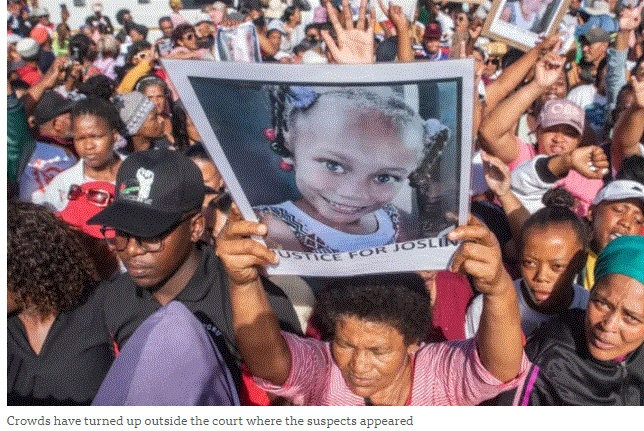The seaside town of Saldanha Bay, South Africa, finds itself entrenched in the mystery surrounding the disappearance of six-year-old Joshlin Smith. Since February, her absence has stirred a whirlwind of emotions and actions, revealing underlying community tensions and fears.

The huge search operation that involved the navy as well as local volunteers, the big reward and the arrest of her mother have served to make this an irresistible story. But the community living with its day-to-day reality remains scared.
Saldanha Bay, about 120km (75 miles) north-west of Cape Town, has the reputation of being a tranquil, quaint town known for its fishing, watersports and magnificently colourful wildflowers that bloom in spring in the town’s nature reserve.
Despite the end of apartheid 30 years ago, the spatial planning in Saldanha, like most cities and towns in South Africa, still reflects the inequalities bequeathed by the system of separate and unequal development.
As one enters the town through the business district, the upmarket housing, which includes guest houses and holiday homes, is located close to the coastline.
But when going into the areas of Diazville and Middelpos, which comprise a mixture of low-cost and informal housing, there is a noticeable change.
The homes in Diazville are mostly government-subsidised basic brick and mortar structures, known as RDP (part of the Reconstruction and Development Programme) homes. In the adjacent Middelpos area there’s a mixture of RDP homes and corrugated iron shacks built on an open field.
There is a marked sense of anxiety and suspicion in the two communities, particularly when they see an outsider or a car that is not from the area. The rise in the number of parents and guardians eagerly waiting to collect their children outside the gates of the modest Diazville primary school is an indication of how much more care is being taken by residents to ensure the safety of young children in the area.
Faeeza Ecksteen, one of the parents who was prepared to talk, was at the school Joshlin attended to fetch her six-year-old son Aleem.
She says the disappearance of Joshlin, also spelled Joslin, has had a serious impact on the community, particularly the children.
“It’s a very sad story. All parents are now worried about the wellbeing of their children and are taking extra care to ensure their safety.”
“It’s traumatising for the children in the area because they no longer want to play outside,” adds community activist Carmelite Ross.
“My 11-year-old daughter, Keayondre, didn’t want to go to school for the first few days after Joshlin’s disappearance because she was scared, even though the school is just a few minutes away. She now walks to school every day with six other children.
“At the end of the day everyone in Saldanha, even our children, has been dragged into this matter.”
Ms Ross, who participated in many of the searches for Joshlin in the first few days after the little girl’s disappearance, chose to step back for her own wellbeing.
“I decided curtail my involvement in the Joshlin case because it started to take an emotional toll on me.
“As a mother myself, it’s very painful. I’ve had sleepless nights because if it were my child I don’t think I would still be alive due to all the worries, stress and everything that you have to deal with.”
Two weeks after Joshlin’s disappearance from her modest shack in the Middelpos informal settlement, police arrested her mother Racquel “Kelly” Smith, Smith’s boyfriend Jacquen “Boeta” Appollis, Steveno van Rhyn and Phumza Sigaqa. That dwelling has since been locked up and stands deserted.
The four first appeared in the local magistrate’s court on 7 March on charges of human trafficking and kidnapping. A large crowd of local people gathered around the court to call for “justice for Joshlin”.
The first few days after her disappearance was accompanied by some racial tension between coloured (as people of mixed racial heritage are known in South Africa) and black members of the community following the arrest of Ms Sigaqa, a black person. She was caught up in a maelstrom of rumours and media reports incorrectly identified her as a traditional healer, or sangoma.
“There were days where people of this area labelled us as if we are the causes of Joshlin’s disappearance. There were days when people were suspicious of sangomas, doing wrong things,” Liwani Siyabulela, ward councillor for Middelpos, tells the BBC.
“We’ve managed to address the issues – we’ve made it clear it’s not about being coloured or black or white, Indian or whatever. We should focus on finding the missing child. At least now the atmosphere is back to normal,” says Ms Siyabulela, a member of the governing African National Congress (ANC).
Ms Ross acknowledges there may have been racial tensions initially but is happy that they were quickly resolved.
“I’ve never experienced such unity in this community. Everyone, no matter what race or culture – they were all there helping with the search. I saw the unity in our people.”
Ms Sigaqa has been freed after charges against her were withdrawn due to a lack of evidence. She has since left her home which is just a few metres from where Joshlin lived following threats from members of the community.
The 32-year-old said in an interview with national television station Newzroom Afrika that police tortured her while she was in custody. The police have not responded to the allegations.
Lourentia Lombaard, who was reportedly the last person to see Joshlin before she went missing, was later arrested and is still in custody.
According to National Prosecuting Authority spokesperson Eric Ntabazalila, Ms Lombaard has made a confession although more information will only be provided at a later stage.
The other three in custody have not commented on the charges, but Ms Smith had previously told local publication The Daily Voice that she had not given up hope of finding her daughter.
“My motherly instincts are telling me my daughter is still alive and in this area. We will find her, I will walk on foot to find her. I will look in every little shack, I’m going to do it by myself if I have to.”
The disappearance of children continues to blight South African society.
According to Bianca van Aswegen, national co-ordinator of Missing Children South Africa (MCSA), figures released by the country’s missing persons bureau in 2013 said that a child goes missing every five hours in the country, but they have not been updated since then.
MCSA statistics show that just over three-quarters of the children are found but the others are suspected to be trafficked or killed.
The massive attention around Joshlin’s disappearance, while welcome, is also intriguing since the same attention was not given to most of the other cases where children have gone missing.
“It could be that Joshlin’s case hit social media by storm. Unfortunately, lots of people spread false information in the process which has hampered the investigation,” says Ms Van Aswegen.
Back at Joshlin’s school everyone is hopeful that she will be found alive.
On the wall of the entrance hall there is a collection of messages of support from different classes alongside her portrait.
The school has also posted a video on its Facebook page in which an assembly of children sings “God will work it out”.
But the young pupils also need to find a way to focus on themselves, school principal Lee-Ann Davids-Hartzenberg says.
“We are still hoping and praying for Joshlin’s safe return, but need to operate and function daily to the best of our abilities. We need to move forward. Things are better this term but Joshlin’s classmates are still missing her in the classroom.
“They regularly sing a hymn that she liked and they are also growing a plant in the class for her.”
Source: BBC News







